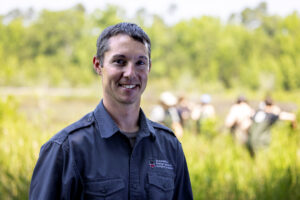Lions and hyenas are a familiar sight to tourists visiting Africa, with many looking forward to seeing them in person. But the animals may occasionally spend less time near roads crowded by humans, according to new research from the University of Georgia.
Etosha National Park in Namibia is a popular site to see animals like lions and hyenas. There are many human-made waterholes that animals gather around, often near the main road frequented by vehicles so tourists can get a good look.
But the presence of tourists can disrupt animals' usual habits and schedules.
"The message here is not that tourism is bad. These large predators need large areas to roam and access prey, and tourism is a huge driver of many economies," said Jim Beasley, co-author of the study and a professor in UGA's Warnell School of Forestry and Natural Resources.
A main goal of his lab is understanding how carnivores and other wildlife use space to protect them from conflict with humans. This is especially important for extremely large parks like Etosha, which has many areas for animals to go where humans are less frequent.
"It's important that we have these large parks that are accessible to tourists so they can come see these animals in the wild," Beasley said. "But we should make sure that there are areas within these parks that these animals can go where there's less tourism pressure."
Animals partial to less crowded areas
The researchers used GPS collars to track the movements of 14 lions and nine hyenas from 2016 to 2024. They found that while lions and hyenas didn't avoid busy areas completely, they did tend to stay near roads that weren't as crowded, especially during the dry season.
"The dry season is when tourism is highest, so there's going to be a lot more traffic," said Jessy Patterson, lead author of the study and a doctoral candidate in UGA's Warnell School of Forestry and Natural Resources. "The animals are still staying in that area because that's where a number of waterholes are found, but they're going to be found in the parts that are closer to the less trafficked roads."

Hyenas were less likely to stay near waterholes, possibly to avoid confrontations with lions. (Photo courtesy of Brennan Peterson Wood)
Lions seek out water more than hyenas
But the animals weren't moving just because of people, the researchers said. Lions often stayed near waterholes, likely to drink or hunt.
Hyenas, however, didn't stay near water as often. This could be because they get more water from their prey. But the animals could also be trying to avoid competition with lions that frequent the waterholes.
Lions also preferred areas with less plant cover compared to hyenas. Lions are ambush predators that use vegetation to hide, so the researchers said this finding was surprising.
"Sometimes, if the vegetation is really dense, lions aren't able to hunt as successfully," Patterson said. "Also, herbivores are more fearful on a landscape with large predators. They know if they're near these areas of vegetation, lions can hide and ambush them. So, herbivores may be avoiding those areas for that reason, which means lions have to go hunt more in the open areas."
By contrast, hyenas preferred places with more tree cover, likely so they could get out of the sun and cool off in the shade.

Knowing where large predators, like this lion, spend their time could help park officials keep animals safe while also boosting tourism. (Photo courtesy of Stephanie Periquet Pearce)
Studying animal behavior important for park management
Though no two regions have the exact same landscape, the researchers stressed the importance of understanding areas where large predators choose to rest and hunt. Knowing this could help park officials manage roads and waterholes while making sure animals stay safe and visible to tourists.
"National parks where these large carnivores occur are really important areas for conservation but also tourism," Beasley said. "Tourism brings in a huge amount of revenue to a lot of countries, and many people want to go see large carnivores in the wild."
The study was published in Global Ecology and Conservation and co-authored by Stephanie Periquet-Pearce, Madeline H. Melton, Brennan PetersonWood, Dipanjan Naha, and Claudine Cloete.







